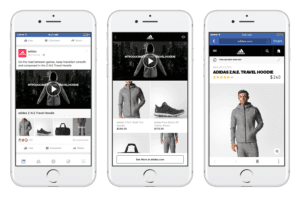Facebook Inc.’s newest shopping ad format, which it calls Collection, aims to drive product discovery while also presenting mobile users who tap on the ad a direct-response format that leads them to click and buy. The ads will begin rolling out Thursday.
Collection provides a mobile ad format for retailers to tell “visual product stories,” says Maz Sharafi, Facebook’s director of product marketing. The ads feature a primary video or image above product images. When a user clicks on the ad, it quickly opens a full-screen display that features up to 50 products at a time. Clicking on a product then takes the shopper to the product page on the retailer’s website or app.
There are two ways to create the new ads: Retailers can manually select the images that appear below the product image and in the larger display that appears when the ad is clicked. Or, Facebook can draw on the product catalog the retailer has uploaded to the social network to dynamically and automatically place products in those spots based characteristics defined by the merchant.
“Our idea was to create a powerful, engaging ad format that pairs video and related products, but that also delivers a fast experience,” Sharafi says. “Ultimately, we want to get people quickly to where they can buy the product.”

In that way, the ad format mirrors Pinterest’s Promoted Video ads, which also seek to mash together a branding component—namely a video—with a direct-response component. Pinterest’s Promoted Video ads are timed to play at the same pace with which the user scrolls down a page. When a shopper clicks on the video it opens Pinterest’s native video player. The video ad is then presented with the advertiser’s promoted pins featuring products shown in the videos below the video.
The ads are also similar in that respect to Facebook’s Canvas format, which let retailers “tell stories” and showcase products. But Collection makes it much easier for retailers to put together an ad, Sharafi says.
“This is much easier, much more automated,” he says. To create an ad a retailer needs to provide an image or video and upload its product catalog. Conversely, Canvas ads are fully customizable, which means retailers can mix together video, still images, text and call-to-action buttons within the full-screen ad.
In addition to rolling out Collection, Facebook is testing a new metric—outbound clicks—over the coming weeks. The metric will show the number of clicks that lead consumers off of Facebook from an ad.
In introducing outbound clicks, Facebook aims to mitigate confusion over the social network’s link-click metric that retailers and other advertisers have had with Canvas. Confusion arose because clicks made to open the ad and clicks that took a consumer off of Facebook could fall into the same bucket if time passed between the two actions.
“We want to make it really clear what actions a consumer took,” Sharafi says.
Favorite